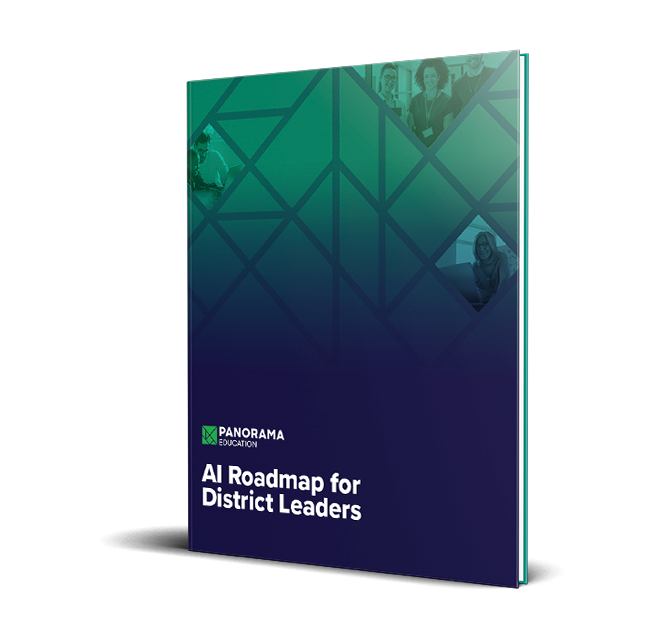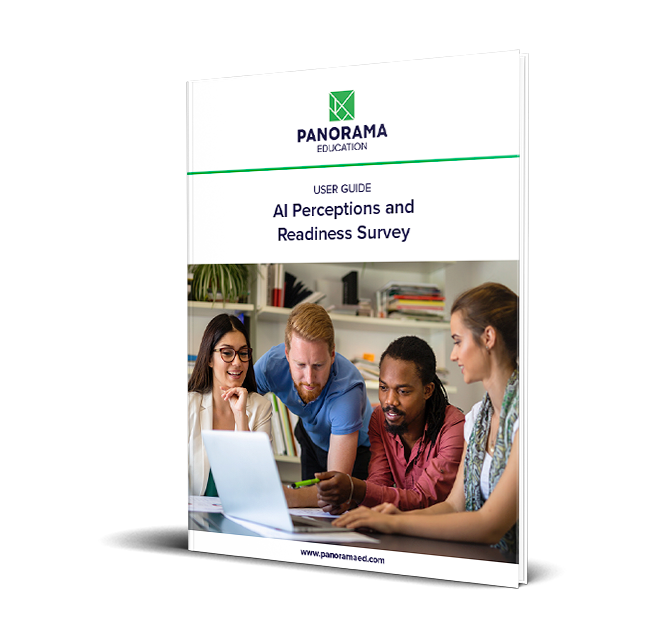Artificial intelligence can help teachers spend less time on tasks like grading, administration, and lesson planning—and 65% of educators already see AI as a solution. But the real story isn’t about what AI replaces; it’s about the possibilities it creates.
Keep reading to explore how AI is transforming teaching, allowing educators to focus less on tracking data and more on supporting and inspiring their students.
How AI is Transforming Teaching
A vast majority—97%—of education leaders agree that AI has the potential to improve learning, and 56% of educators now use AI tools regularly to support their work. As students integrate AI more deeply into their lives, teachers face both new opportunities and responsibilities, balancing AI’s benefits with the responsibility of guiding students in its appropriate use.
While AI makes personalized learning more accessible, educators must also ensure students use it ethically and responsibly. Let’s take a closer look at how AI is reshaping the teaching process:
Assessment and Feedback
AI tools can assist teachers in gathering student data and providing personalized feedback, enabling more targeted instruction and support. Additionally, AI can help with:
-
Feedback Support: Smart systems can analyze student responses, offer feedback, and streamline the evaluation process for all kinds of assignments—cutting down on busy work so teachers can focus on what matters most.
-
Track Student Progress: AI makes it easier for teachers to monitor individual learning patterns and identify when students need extra support. AI-enhanced tools like Panorama Pathways provide valuable insights, helping educators understand exactly what each student needs to succeed.
-
Personalized Assessments: Experts predict that AI will transform student assessments, making them more personalized than ever. AI-driven evaluations are already being tested, adapting to each student’s learning needs, interests, and career aspirations.
Content Creation and Delivery
AI is making it easier than ever before to create fresh learning materials, giving educators powerful tools to connect with their students.
-
Plan Lessons: AI platforms can help produce complete lesson plans tailored to learning objectives. Specialized solutions can help teachers quickly develop engaging content that aligns with curriculum standards while saving hours of preparation time.
-
Multilingual Support: With advanced translation capabilities, teachers can now instantly develop resources in multiple languages to support diverse classrooms.
-
Interactive Learning Modules: Modern AI applications can transform static content into dynamic, adaptive learning experiences. Text-to-video tools can turn lessons into engaging videos and generate special activities tied to existing assignments.
-
Differentiate Content: AI makes it possible to quickly modify learning materials to suit various ability levels. Natural language processing tools can take a single lesson plan and generate multiple versions for each student.
Student Support Systems
AI can be a valuable tool for teachers, offering extra support through AI-powered platforms that provide students with additional practice exercises or help answer basic questions. It can also assist with:
-
Identifying Support Opportunities: With at-a-glance dashboards, solutions like Student Success allow teachers to recognize when students need additional support with any academic, behavior, or attendance challenges.
-
Custom Learning Paths: AI educational platforms can also be used to create personalized learning journeys based on each student’s performance data. These adaptive systems allow teachers to adjust content and pacing to match the needs of individual students.
Administrative Tasks
AI is considerably reducing the time teachers spend on paperwork and planning, with new tools emerging daily that further simplify administrative work.
-
Documentation Automation: When done securely, generative AI can be used to simplify documentation. It can be used to create progress reports, to learn summaries and individual education programs (IEPs), and to help out where possible.
-
Drafting Communication: AI-powered tools can quickly generate email templates, announcements, and parent updates, helping teachers communicate with stakeholders efficiently while maintaining a consistent and professional tone.
Classroom Management
AI can help teachers with tasks like tracking attendance, analyzing student engagement during lessons, and identifying patterns in behavior that may need attention or positive reinforcement.
-
Monitor Engagement: AI tools can monitor everything from time spent on tasks to participation in group discussions, giving teachers on-demand engagement statistics. These analytics empower educators to take action early and address underlying issues before more significant problems like chronic absenteeism can develop.
-
Assist with Grouping: Thanks to its ability to analyze data immediately and surface critical insights, AI can automatically suggest optimal student groups based on academic performance and learning styles. This saves teachers time and helps students get more value from collaborative learning experiences.
Top Benefits of AI for Teachers
Districts face a growing challenge: overburdened teachers juggling grading, lesson planning, and administrative tasks—leaving less time for individualized student support. Educators are stretched thin, making it harder to focus on what matters most—engaging students and driving learning outcomes.
By adopting AI, districts can empower teachers with smarter tools, freeing up their time for meaningful instruction, fostering a more personalized learning experience, and ultimately improving student success. Here’s how AI can support educators:
- Decision Confidence: With AI-backed insights and data analysis, teachers can make more confident decisions about instructional strategies, interventions, and resource allocation
- Creativity Boost: By handling routine tasks, artificial intelligence frees teachers to focus on the creative aspects of their teaching, empowering them to experiment with innovative methods and projects.
- Collaboration Enhancement: AI platforms for education commonly include a range of communication and file-sharing features so teachers can share resources and ideas with colleagues, reducing professional isolation.
- Better Work-Life Balance: Until now, teachers staying late or working weekends to do paperwork was common. Artificial intelligence is rapidly eliminating many of these tasks, helping educators reclaim their time, preventing burnout, and increasing job satisfaction.
Challenges of Using AI in Teaching
Despite its potential benefits, integrating AI into education comes with challenges. Protecting student data is essential, as is anticipating and addressing biases in algorithms to ensure fairness for all students. Another key challenge is ensuring that teachers and staff receive proper training and ongoing support to successfully implement AI tools in the classroom.
-
Learning Curve: Studies show that most teachers have had little to no formal training in AI, making it difficult to navigate and effectively use modern AI-powered educational tools. Without proper guidance, many educators struggle to integrate AI into their teaching practices.
-
Privacy Concerns: The vast amount of student data collected by AI systems raises serious questions about security and privacy rights. Districts must ensure that AI tools align with strict data protection standards to safeguard sensitive information. Given this, selecting an AI partner that prioritizes data security is essential. Panorama is committed to data security and privacy, fully complying with SOC 2, FERPA, COPPA, and the Student Privacy Pledge to ensure the highest standards of protection.
-
Tool Selection: With so many AI education platforms available, it’s up to districts to choose solutions that truly support teachers and students. Educators need reliable, research-backed tools that integrate seamlessly into their workflow—without adding extra burden.
How to Prepare for the Future of AI in Teaching
As AI becomes more widely adopted, districts must prioritize teacher readiness and invest in the necessary technology infrastructure to support its effective use. Here are some best practices to ensure AI enhances teaching and learning in K-12 classrooms
-
Create District-Wide AI Policies: Districts must develop comprehensive AI governance frameworks that safeguard student privacy while maximizing AI’s educational benefits. These policies should clearly outline acceptable AI use cases, data protection protocols, and ethical guidelines tailored to K-12 education, ensuring responsible and effective implementation.
-
Develop Teacher Training Programs: Effective AI integration starts with practical, hands-on training for the specific tools your district adopts. Ongoing professional development ensures educators feel confident using AI to enhance teaching and learning. Additionally, districts should provide continuous technical support before, during, and after implementation to address challenges and maximize success.
-
Build Support Systems: Empower tech-savvy educators to support their colleagues by leading AI mentorship programs. These peer-led networks can build confidence, foster collaboration, and accelerate AI adoption across the district, ensuring a smoother and more effective implementation.
-
Establish Pilot Programs: Before rolling out AI district-wide, launch pilot programs in select classrooms. These controlled trials provide valuable insights into what works, what needs improvement, and how to refine AI integration for a successful, district-wide implementation.
-
Design Grade-Appropriate Frameworks: AI applications should be tailored to different grade levels, as elementary students have different needs and abilities than high schoolers. Districts should establish clear, developmentally appropriate guidelines to ensure AI is used effectively and ethically at every stage of learning.
-
Create A Detailed Budget: Long-term success with AI requires more than just an initial investment. Districts must budget for ongoing training, technical support, and regular system updates to ensure AI tools remain effective, secure, and aligned with evolving educational needs.
How Panorama Solara Empowers Educators with AI
As AI continues to shape education, teachers have a unique opportunity to lead the way. By leveraging AI as a powerful tool—while preserving the irreplaceable human elements of teaching—educators can create more engaging, equitable, and personalized learning experiences for every student.
Today’s educators need tools that match their commitment to student success. Panorama Solara provides a comprehensive AI solution for K-12 education. Combining secure data analysis and intelligent automation, this platform offers a range of features to support every aspect of teaching:
-
Secure Data Management: Ensures all information remains within the Panorama ecosystem, maintaining privacy and compliance with educational standards.
-
Customizable Lesson Planning: Generates detailed lesson plans aligned with district curricula, enabling differentiation, localizing existing resources, and creating new materials to meet diverse classroom needs.
-
Personalized Student Interventions: Creates tailored support plans, such as attendance interventions and behavior improvement strategies, to address individual student needs.
-
Instant Insights: Provides immediate access to student data, enabling informed decision-making and timely interventions.
-
Efficient Communication Tools: Enables the creation of family engagement materials, like attendance nudge letters, to promote collaboration between educators and families.
-
Research-Backed Resources: Offers a library of evidence-based prompts and tools to support instructional design and classroom management.
-
AI Usage Analytics: Delivers comprehensive dashboards that track how AI tools are used across the district, aiding in governance and resource allocation.
-
Integration With Existing Systems: Connects with district data sources, ensuring a unified approach to student support and progress monitoring.
Ready to see how Panorama Solara can support teachers in your school?
Book a live demo today!






